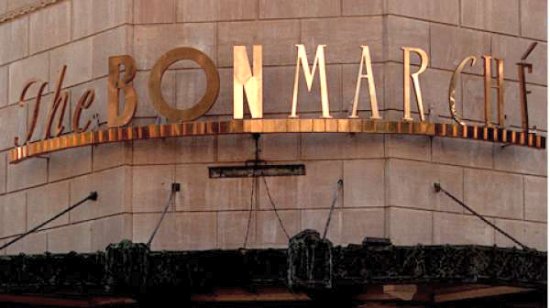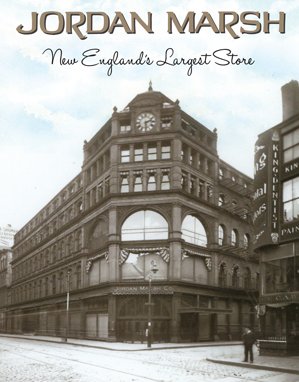TSI’s dealings with Federated and Macy’s Inc. Continue reading
For more than a decade after TSI began marketing AdDept, its software system for retail advertisers, the chain of department stores now known as Macy’s Inc. was called Federated Department Stores (FDS). The company was acquired in the eighties by Robert Campeau, a Canadian real estate magnate. For a short time it was merged with Campeau’s other stores and called Federated and Allied Department Stores. In 1992 the company emerged from bankruptcy as FDS, the same year that Macy’s filed for Chapter 11 protection. In 1994 FDS found enough cash in the cushions of the sofas in the furniture departments of its stores to purchase Macy’s shortly after Santa’s favorite retailer emerged from its own bankruptcy. Details of the takeover can be read here.
In the early nineties I was just beginning to learn about retail in America. It shocked me that a bankrupt company could stiff all of its vendors and then have the wherewithal to buy another company of about the same size. A lot of craziness like this happened in the nineties. I never did figure it all out, and the two companies involved in this transaction were a thorn in the side of TSI for the rest of its existence.
In 1992 FDS had eight regional divisions. Each division produced and placed its own advertising from the divisional headquarters. The first FDS division that contacted TSI about purchasing the AdDept system was the Bon Marché, which was based in Seattle. I was called by Val Walser1, the Director of the Advertising Business Office there. She had received one of TSI’s mailings in late 1989 or early 1990, and she thought that the system might be what they needed. I talked with her in person twice, once at the Retail Advertising Convention in Chicago and once in Seattle. I gave Val a private demonstration in Chicago, and I showed the system to the rest of the team in Seattle. Those encounters have been described in some detail here.
I don’t think that I knew at the time that the Bon Marché was part of FDS. Even if I did, I don’t think that I realized then that the parent company was about to declare bankruptcy. I was inexperienced; I probably made some errors in judgment. Perhaps I made a mistake by proposing a system that would only be minimally sufficient for their existing operation. Maybe we did not follow up often enough or in the best way.
Although Val informed us that she had requested funding for the system, it was never approved, and after a while we did not hear any more from her. We continued to send materials to her periodically. Until I began the research for this entry I was unaware that she had any involvement in deploying a system that was initiated by the FDS division most distant from Washington, Burdines in Florida. Val apparently oversaw the development of the administrative part of the FedAd (or whatever it was called at that time) system. By then her division was known as Macy’s Northwest, which was folded into Macy’s West, a long-time AdDept user, in 2008.
TSI’s fruitless contacts with Burdines have been documented here.
From the beginning I thought that Jordan Marsh, the Boston-based department-store chain, would be a valuable customer for TSI. Like the Bon Marché, Jordan Marsh was actually part of the Allied group before Campeau acquired Federated and merged all the stores into one gigantic chain. At one time there were also Jordan Marsh stores in Florida and San Diego, but by 1991 all of those stores had closed or were no longer controlled from Boston.
Kate Behart, whose career at TSI is described here, arranged for me to do a demo for people from Jordan Marsh’s advertising department at an IBM office. I don’t remember any of the names of employees at Jordan Marsh. In fact, the only things that I remember about our meeting with them were that Kate was very upset that I had used the word “gals” at one point and that they informed us that they wanted our system.
I am sure that Kate must have followed up on the presentation. She was very conscientious. However, nothing came of it.
Bloomingdale’s, the high-end department store with headquarters in New York City, contacted TSI several times. The last of these exchanges of telephone calls was handled by Doug Pease, whose successful marketing career at TSI is detailed here. We certainly sent them detailed materials about AdDept and the AS/400. I might have done a demo for them at the IBM office. I clearly recall that we went to their headquarters in Manhattan and gathered specs about their needs. I can still picture the Manager of the Business Office, who wore a three-piece suit and had a long pony tail. Guys with pony tails were not unusual in the creative and production areas of advertising departments, but he was the only one that I ever saw in the financial area.
Doug followed up on our visit with several telephone calls. At one point he became certain that Bloomies would buy the AdDept system. Nevertheless, not long after he had voiced his certainty, he got the telephone call that dashed his hopes. He never told me the details, but he was visibly upset about it.
One of the biggest disappointments in my career was not being able to land Liberty House, the department store in Hawaii and the Pacific, as a client. When Doug, Sue, and I flew out to Honolulu in December of 1995 to meet with Karen Anderson (detailed here), Liberty House was an independent chain of stores that included both department stores and much smaller stores in locations convenient to tourists. Those stores specialized in “resort ware”.
Our presentation went very well. Karen told Doug in a subsequent conversation that she had requested funding for AdDept, but there was a freeze on capital purchases. The freeze persisted until the company entered bankruptcy in 1998 and closed most of the resort stores. When it emerged from bankruptcy it was gobbled up by FDS. At that point the remaining stores were relabeled as Macy’s, and administrative functions were transferred to Macy’s West in San Francisco, one of TSI’s clients.
So, this was as close as we came to a victory in our dealings with FDS/Macy’s Inc.. Many of the newspapers that had been used by Liberty House still subscribed to AxN in 2014.
At some point the AS/400 systems used by the three Macy’s divisions that used AdDept—Macy’s East, Macy’s South, and Macy’s West—were moved to the headquarters of Federated Systems Group (FSG) in Alpharetta, GA, a suburb of Atlanta. I flew down there to consult with Len Miller2, who was in charge of all of the FSG’s AS/400s. I don’t remember exactly what the agenda for this meeting was, but I remember that Len said that long-range plan of FDS was to replace the AS/400 systems with home-grown software running on other platforms. However, he assured me that at that point—soon after the merger with the May Company—it was a very low priority. They would still be using the AS/400s for several years.
My other vivid memory of that day was when we passed a room that contained perhaps twenty desks. At each desk sat someone working on a computer. All of the people were IBM employees who were consultants for Federated.
Len’s predictions both turned out to be true. All of the divisions except Bloomingdale’s were eventually folded into one gigantic Macy’s run from the Herald Square Building in Manhattan. The plan was apparently to use the system built for Burdines and the Seattle division, but it did not have all of the features that the people in New York needed. For several years they maintained AdDept in order to run the Loan Room (merchandise loaned to photo studio for shoots) module that TSI wrote for Macy’s East in the early nineties.
In May or June of 2005 I received a telephone call from Robin Creen3, whose title was Senior Vice-president of Macy’s Corporate Marketing. She wanted me to come to New York to discuss the AdDept and AxN systems. I made an appointment and took Amtrak to Penn Station. Robin instructed me to use the executive elevator at one of the 34th St. entrances rather than the employee’s entrance that I had always used on the other side of the building.
Robin’s office was not in the advertising department. It was on executive row. I don’t remember too much of the meeting, and I cannot locate my notes. I recall that I only got to meet with her once or maybe twice, and I never heard from her or about her again.
I did, however find a copy of a letter that I sent to her on October 7, 2005. Here is the text:
At our last meeting you told me that it was still too early to talk about the future of the existing May Company divisions. Since there have now been several definitive press releases about the makeup of the new Macy’s after the merger, I assume that those restrictions no longer apply.
Needless to say we are concerned about what effect the realignment will have on TSI. We have spent the last 17 years developing AdDept, the software product which has become the standard of the industry for administration of retail advertising departments. The May Company was our largest client.
We know that Federated Department Stores has been working with its Florida division for the last decade or so on a system which overlaps considerably with ours. I am sure that the company has by this time invested a considerable amount of time, money, and manpower in it. It may surprise you to know that I was supposed to be an integral part of the original plan. I met with Mike Rafferty and Gilbert Lorenzo in Huntsville, Alabama, back in the mid-nineties. Their plan at that time was to use AdDept for the accounting functions.
They wanted us to convert our system to run on a PC network using a home-grown relational data base and Microsoft Visual BASIC on each client. To me this seemed like a huge step backwards for us. Their approach would definitely have improved the appearance of AdDept’s front end and provided an integration with the production area, but no one could explain to me how we could possibly support such a system in many locations. The principal problem was that with their proposed architecture someone—presumably TSI—would be required to support both server software and client software. We have never had to support clients—the individual desktop PC’s and Macs. At the time networks were unreliable, Windows was not a mature product, and the Internet was in its infancy. TSI was already supporting a half dozen or more companies, including the two Macy’s divisions, which at the time were not affiliated with Federated. I honestly think that had we participated in the project at the level that they expected, TSI would not have survived as a company. Gilbert and Mike must not have liked my attitude, because we never heard from them again.
Since that time, as I wrote you earlier, most of the rest of the department stores in the country—as well as several other large retailers like Dick’s Sporting Goods—have successfully implemented AdDept in their sales promotion departments. They were able to get affordable systems tailored to their requirements. AdDept is not a sexy system, but it gets the job done.
No one in the entire country—no one—has the experience that TSI has garnered over the last 17 years in understanding the intricacies of administration of advertising systems. We are offering that experience to Macy’s Marketing. Four of the seven newly aligned Macy’s divisions—East, West, Midwest, and whatever the Marshall Field’s division is called—are long-time AdDept users. Lord & Taylor also uses AdDept. Moreover, a large number of May Company employees have considerable experience using AdDept in many different areas. If I were in your shoes, I would consider this as a valuable asset.
TSI has a very strong relationship with its users—both at the corporate and division level. If you talk with the people at the May Company, I am sure that they will verify that we have always done what they asked, that we do an excellent job of supporting our product, and that we give them a lot of bang for the buck.
There is one big additional factor. We are not on their payroll. When they wanted to spend money to make the system do new things, they used us. When they were tightening their belts, they did not have to worry about paying the salaries of programmers, system architects, data base administrators, etc.
So far in our discussions TSI has done most of the talking. What we would really like now is to learn what you and the other people in Federated’s management need to get out of the system. A goal-oriented approach works best for us. We have moved mountains for other clients, and we would definitely appreciate the opportunity to tell you how we would attack your biggest problems. We have never shrunk from such a challenge in the past. Our track record in this regard is essentially flawless. If someone will tell us what they need, we will provide it.
Do you think that we could schedule a face-to-face meeting with you and whoever else is involved in this project about this challenge? We have always been straight-shooters, and we would be eager to listen to whatever you have to say.
My last two encounters with Macy’s were both about insertion orders for newspaper advertising. TSI had developed and successfully marketed an Internet-based system for insertion orders to newspapers. Macy’s West, Macy’s South, and most of the May Company divisions that FDS acquired in the merger used it, and they all loved it. We called it AxN, which was pronounced “A cross N”.
I knew that, compared to our other AdDept clients, Macy’s East used a small fraction of the programs that comprised AdDept. Still, they were entering the ads, and, therefore, they were a good candidate to use AxN. I wrote to the Media Director, whom I had never met, and requested a meeting about AxN. He seemed very interested. We scheduled a meeting, I made a dozen or so copies of our sales materials for AxN, I packed them in my briefcase, and I boarded the 6:30 train again. I was alone because TSI had no marketing/sales person at the time.
The meeting was not what I expected. It was conducted by a man named Roman from the IT area, not the advertising department. My presentation was very well received. Roman said that it was very impressive.
He pressed me on whether TSI planned to provide a way to send the layouts for ads over the Internet. This surprised me. I thought that this was a problem that had been addressed years earlier. The market leader was the Associated Press’s AdSend service, but I also knew of several competitors. I said that TSI had no plans to enter that market. I explained that we had neither the infrastructure nor the expertise necessary to compete in that arena. Besides, none of our clients had asked for it, and they were not shy about requesting our services.
He said that we should consider it. Macy’s was looking for someone who could enable them to use the Internet for both insertion orders and the delivery of ads, “because, you know, one-stop shopping is better.”
I had three hours on the train to mull this over. I had made a mistake by letting this remark go unchallenged. It seemed like such a silly thing to say. I thought that they would want expertise and experience, not fewer phone numbers.
If one-stop shopping really was the objective, then I had no chance of ever persuading them to use AxN. Therefore, nothing could be lost by asking for proof of any real value associated with having one vendor doing both tasks. I knew very well that the people who placed orders for newspaper ads were completely separate from the employees who created the actual layouts and sent them to the papers. This was true at Macy’s in New York and at every other large retailer that I had met with.
We never heard from them after that.
I learned later that Macy’s East’s advertising department had never used AdDept for insertion orders, even though they could have easily faxed the orders from the AS/400. Instead, each coordinator had developed ways to communicate with the reps at the paper. It sounded chaotic.
My last frustrating encounter with FDS (by then known as Macy’s Inc.) occurred in, I think, 2007. This one revolved around Dave Ostendorf, whom I had known quite well when he had been the liaison between TSI and the advertising department at Famous Barr, the May Company division based in St. Louis. Much more about my relationship with Dave and the installation at Famous Barr is posted here.

Dave called me about the use of AxN. He said that the people for whom he worked in Macy’s Corporate Advertising department asked him to find out how much we would charge for an interface between AxN and the system that had been developed internally. Dave was a very straight arrow. I trusted him (unlike everyone else mentioned in this entry) implicitly.
Of course, I asked for more details, but Dave would not provide them. He was rather sheepish about this. He advised me just to write up a proposal in our usual format with as many disclaimers as I wanted to include. He also specifically warned me not to low-ball it. So, I wrote up a quote for $20,000 that may have set a world’s record for use of phrases like “assuming that”.
A short time after I talked with him Dave resigned his job at Macy’s and moved back to his home town of Indianapolis. Needless to say, no one ever called about the quote. I have always suspected that it had been used as a justification for further investment in the corporate system.
So, my interactions with FDS and its successor Macy’s Inc. were completely fruitless. If FDS/Macy’s Inc. was the Brass Ring of our field of software, it was in sight quite a few times, but we were never able to snatch it.
My only real regret is that I do not completely understand why we continually failed. Our success with every other department store chain was close to universal, and the employees in the advertising departments at FDS and Macy’s divisions seemed enthusiastic about what TSI had to offer. However, in these situations we were up against an amorphous alternative, the system developed for Burdines and the Bon Marché, about which I knew very little.
One thing that struck me when rereading the letter that I had written to Robin Creen. I seemed to be asking for an opportunity to see the alternative. As a debater and a debate coach I was much better on the negative. I seemed to feel confident that if they just told me what they were using or planning to use, I could demonstrate what was wrong with it. Even if our software was lacking in some areas, I felt confident that we knew how to change AdDept to make it better.
Fortunately TSI found plenty of work outside of FDS/Macy’s up until the time that Denise and I were ready to dispose of the business. If some of these opportunities had gone the other way, it seems likely that we would have missed out on some of our other achievements.
1. Val Walser worked int the advertising department in Seattle until Macy’s brought all of her division’s administrative functions to San Francisco in 2008. Her LinkedIn page, which is here, says that she “directed development of a sophisticated, integrated software product, which was Macy’s premier marketing/advertising system managing all departmental functions.” I presume that this refers to the system once known as FedAd that was begun by Burdines.
2. Len Miller apparently still works for Macy’s in 2022. His LinkedIn page is here.
3. Robin Creen left Macy’s in 2008. Her LinkedIn page is here.
4. Dave Ostendorf’s LinkedIn page is here.













Pingback: 1988-1989 TSI: AdDept: The Macy’s Installation | Wavablog
Pingback: 1988-2014 TSI: The Nature of Retail Advertising | Wavablog
Pingback: 1993-1996 TSI: AdDept-Burdines Interface | Wavablog
Pingback: 1991-2012 TSI: AdDept: The Whiffs | Wavablog
Pingback: 1997-2006 TSI: AdDept Client: Parisian | Wavablog
Pingback: 2001-2006 TSI: Weekly Partners’ Meetings | Wavablog
Pingback: 2005-2009 TSI: AdDept Client: Macy’s South | Wavablog